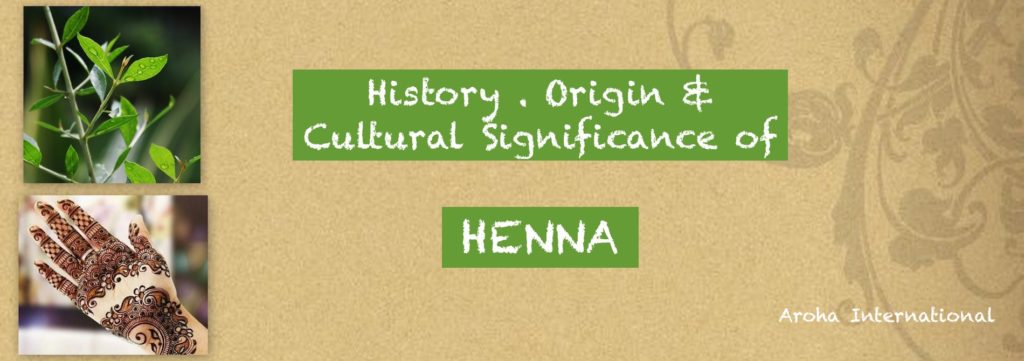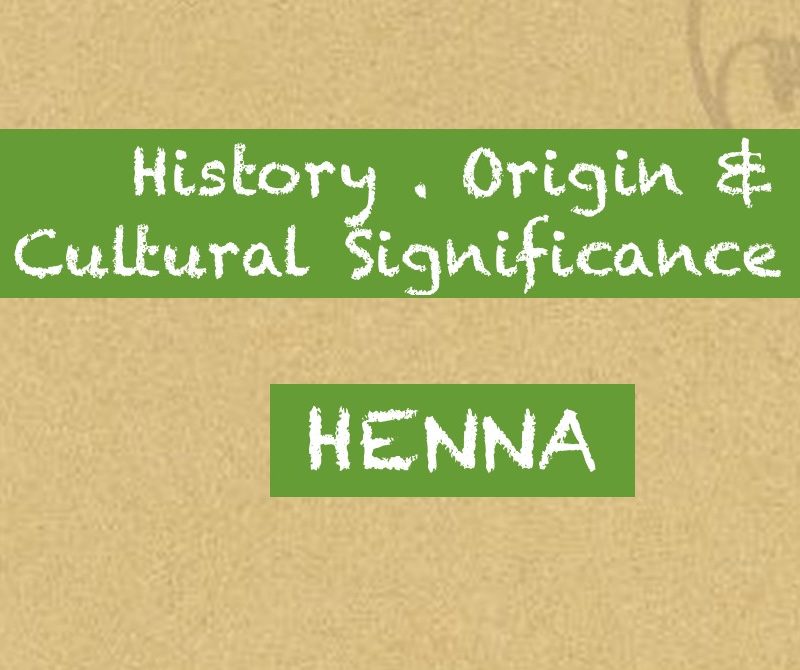Everything You Want To Know About History, Origin & Cultural Significance of Henna
Henna : Meaning
Henna (Lawsonia Inermis) is known around the world by different names like Henne, Al-Hanna, Jamaica Mignonette, Egyptian Privet, etc.
 The word Henna is basically derived from the Arabic word Al-Hinna. It is generally understood to be a shrub-size Flowering plant whose leaves are used to dye skin, hair and finger nails. It contains dying agent named Tannis which leaves Reddish- Brown color on application.
The word Henna is basically derived from the Arabic word Al-Hinna. It is generally understood to be a shrub-size Flowering plant whose leaves are used to dye skin, hair and finger nails. It contains dying agent named Tannis which leaves Reddish- Brown color on application.
The art of decorating skin/ body with different designs is known as Mehandi in Indian Sub-Continental. Women apply many variations of mehandi design patterns on their hands & feet. These Design patterns are called-Arabic Mehandi Designs, Indian Bridal Mehandi designs, Pakistani Designs etc.
Henna is found mostly in Hot-Dry climates as of India, Pakistan, Middle East, African Sub-continents etc.
History & Origin
The history of henna is hard to trace. Due to migration of human kind for years, cultural integration took place, which makes it difficult to determine exactly from where tradition of henna application began. However, historians argue that henna has been used for at least 5,000 years in both cosmetic and healing capacities.
There are evidences that earlier civilization of babylonia, sumerians etc have used henna for decoration of a woman or bride on special occasions. The earliest text mentioning henna in the context of marriage and fertility celebrations comes from the Ugaritic legend of Baal and Anath.
Some researches argue that henna originated in ancient India while others claim it was brought to India by Egyptian moghuls in the 12th century C.E. but the use of Henna in the 4th-5th centuries in the Deccan of western India is clearly illustrated on Bodhisattvas and deities of cave wall murals at Ajanta, and in similar cave paintings in Sri Lanka. The evidence proves henna usage in India seven centuries before the Moghul invasion, and hundreds of years before the inception of the Islamic religion, which began in the mid-7th century AD.
Archaeological research indicates henna was used in ancient Egypt to stain the fingers and toes of Pharaohs prior to mummification. Ancient Egyptians and many indigenous and aboriginal people around the world believed that the naturally derived red substances of ochre, blood and henna had qualities that improved human awareness of the earth’s energies. It was therefore applied to help people keep in touch with their spirituality.
Religious significance
Henna has found its place in the Religions all around the world. Hinduism, Sikhism, Buddhism, Islam, Judaism have mainly embraced henna in their cultures.
 Traditionally, Henna has been used for centuries for body decoration and is associated with many cultural celebrations. People in the early civilization used it primarily for cosmetic purposes & to adorn their hands & body. Ancient Egyptians used it prior to mummification to dye hands and nails. It has also been used in Southern China and was associated with rituals for purpose of spirituality.
Traditionally, Henna has been used for centuries for body decoration and is associated with many cultural celebrations. People in the early civilization used it primarily for cosmetic purposes & to adorn their hands & body. Ancient Egyptians used it prior to mummification to dye hands and nails. It has also been used in Southern China and was associated with rituals for purpose of spirituality.
Henna in Indian Culture
Henna finds its place in many traditions in India. Its application has been deeply associated with sentiments of general public. Even God & Goddesses of Hindu Religion are seen in pictures adorning henna designs on their hands. It is applied on almost all the special occasions & festivals throughout the year.
 The art of Henna-application is called Mehandi in India. Mehandi is integral part of many festivals. It is mainly applied on celebrations like Engagement ceremony, weddings, on the birth of child, naming ceremony, on occasions of observing fasts such as Karwa Chauth, Teej, Diwali, Eid etc.
The art of Henna-application is called Mehandi in India. Mehandi is integral part of many festivals. It is mainly applied on celebrations like Engagement ceremony, weddings, on the birth of child, naming ceremony, on occasions of observing fasts such as Karwa Chauth, Teej, Diwali, Eid etc.
The Hindu marriage season is a special time for Henna tattoos or ‘Mehandi’. Mehandi is considered among the most auspicious ‘ornaments’ of a married woman. Traditionally it is thought that the darker the Mehandi on the bride’s hand, the more intensely her husband will love her.
Even in Muslims, “Mehandi-ceremony” during wedding ceremonies has become a common practice.
The Art of Henna Application
 Mehandi is applied in various types and styles. Henna Paste is made by grounding dry henna leaves which is then used in making various beautiful designs. These Mehandi designs have given names as- Arabic Mehandi Designs, Indian Bridal Mehandi, and Pakistani Mehandi Designs etc. These Various designs have different meaning for members of each culture . For Ex: good health, fertility, wisdom, protection and spiritual enlightenment.
Mehandi is applied in various types and styles. Henna Paste is made by grounding dry henna leaves which is then used in making various beautiful designs. These Mehandi designs have given names as- Arabic Mehandi Designs, Indian Bridal Mehandi, and Pakistani Mehandi Designs etc. These Various designs have different meaning for members of each culture . For Ex: good health, fertility, wisdom, protection and spiritual enlightenment.
Arabic henna designs are abstract and less dense with designs featuring graceful, usually large, Floral and vine patterns on the hands and feet. While Indian mehandi involves fine, thin lines for lacy, floral, paisley patterns with lines and dots; dense patterns covering entire hands, forearms, feet and shins.
Today, the art of Henna-tattooing has become a fashion statement. It is preferred over permanent tattoos as it does not have any Side Effects. It is also painless and temporary in nature so that you can get away with the impression in some days if you really do not like it.
People apply henna tattoo in various designs depicting different symbols and meanings. This richly beautiful art knows no boundaries in culture, ethnicity, gender, religious or spiritual beliefs.
Henna is also applied on hair to get rid of many hair related problems. It has anti fungal and antibiotic properties. It also acts as cooling agents in skin ailments.
All we can say is that Henna (Mehandi) is truly a gift of nature to us.
You May Also Like to Read



